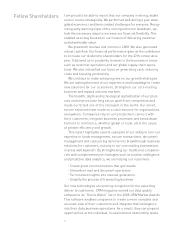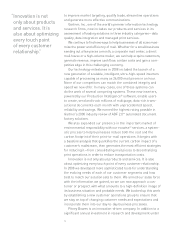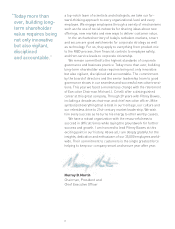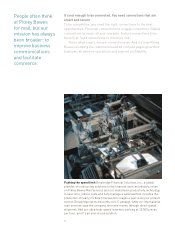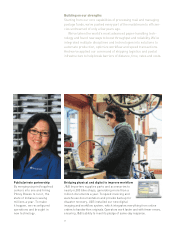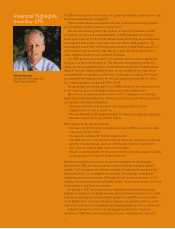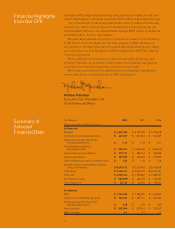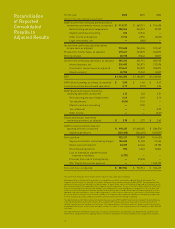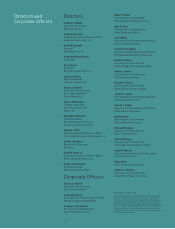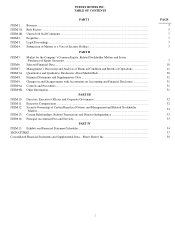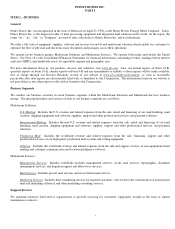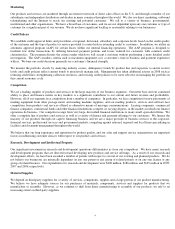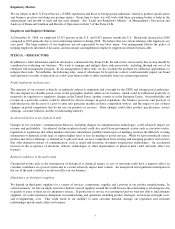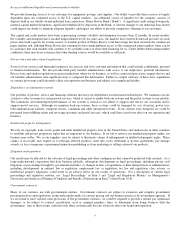Pitney Bowes 2008 Annual Report Download - page 15
Download and view the complete annual report
Please find page 15 of the 2008 Pitney Bowes annual report below. You can navigate through the pages in the report by either clicking on the pages listed below, or by using the keyword search tool below to find specific information within the annual report.
13
In 2008 we took actions to increase our operating effi ciency, optimize our cost
structure and enhance our liquidity.
These actions helped us increase full-year revenue and earnings despite
an increasingly volatile economic environment.
Our annual revenue grew to $6.3 billion, a 2 percent increase, on both
a constant currency and a reported basis. In 2008 adjusted earnings per
share grew 2 percent to $2.78 per diluted share. Both revenue and adjusted
earnings per share were in line with our most recent 2008 guidance. Our
earnings per share from continuing operations on a GAAP basis was $2.13,
which was 31 percent better than the prior year, primarily as a result of
lower charges related to our transition initiatives.
Our 2008 performance is even more notable when the year’s signifi cant
swings in currency are factored in. The dramatic strengthening of the U.S.
dollar, primarily against the euro, the British pound and the Canadian dollar,
had a 5-cent-per-share negative impact on our results for the year, when
compared with our guidance at the start of the year. Excluding this impact,
our adjusted earnings per share for the year would have been $2.83, within
our original guidance range of $2.80 to $2.90.
We generated robust free cash fl ow of $888 million for the year as a result
of our ongoing focus on the balance sheet and cash management.
We continue to maintain a short-term A-1/P-1 rating as a commercial
paper issuer and have taken the following actions to ensure that we preserve
our liquidity and fi nancial fl exibility:
•We have instituted more stringent risk-adjusted rate-of-return
requirements for new acquisitions.
•We have eliminated 2009 salary increases for many of our salaried employees.
•We have chosen not to repurchase shares.
With respect to the capital markets:
•We have only $150 million in bonds maturing in 2009, and no term debt
maturing in 2010 or 2011.
•We have an undrawn $1.5 billion credit facility.
•Our debt and our credit facilities have no fi nancial covenants or material
adverse change clauses, and our credit facility does not mature until
2011, with all original bank commitments intact.
•We are currently eligible for the government’s commercial paper funding
facility program through the Federal Reserve.
We had strong performances in our portfolio despite the challenging
environment. Mail services achieved continued strong revenue and profi t
growth. Cost management initiatives resulted in higher profi t margins in the
production mail, U.S. management services, international mailing and
marketing services businesses. Although annual results were lower in U.S.
mailing, we saw good equipment sales growth in the fourth quarter as more
leases became available for renewal.
At the end of 2007 we announced our transition initiatives restructuring
program in response to changes we were seeing in the environment and in order
to enhance our long-term positioning for growth. During 2008 we took an addi-
tional $200 million of pretax charges to improve our operating effi ciency and
reduce our cost structure to address the changing global economic environment.
A signifi cant portion of the cost savings generated by our transition
initiatives in 2008 was reinvested during the year, including an 11 percent
Financial Highlights
from Our CFO
Michael Monahan
Executive Vice President and
Chief Financial Offi cer


